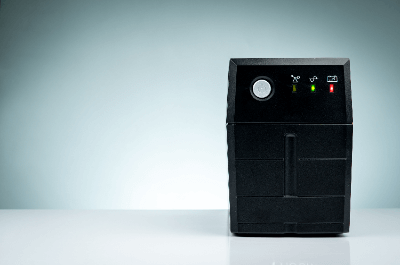What Is a UPS ?
 A UPS is a device that supplies power to load equipment for a certain period of time in the event of a power failure due to a power outage. UPS stands for Uninterruptible Power Supply.
A UPS is a device that supplies power to load equipment for a certain period of time in the event of a power failure due to a power outage. UPS stands for Uninterruptible Power Supply.
Since power grid outages generally last from a few seconds to a few minutes, the use of a UPS can often avoid equipment shutdowns.
In addition, computers and other electronic equipment are at risk of malfunctioning or losing internal data in the event of a sudden power outage; connecting a UPS provides power for a period of time that allows electronic equipment to safely shut down in the event of a power problem.
Uses for UPS
UPS devices are used when you have critical computer and communication equipment. The following are examples of UPS applications:
- Computers and office automation equipment
- Network equipment
- POS terminals and customer information terminals in stores
- Security and disaster prevention equipment
- ATM terminals and online terminals
- Broadcast equipment and electrical equipment
UPS may be used in combination with power management software. These software programs can automatically and safely shut down or start up equipment in the event of a power failure.
Principle of UPS
A UPS typically consists of the following circuits:
1. Converter
A converter is a device that converts AC power to DC power. Electricity supplied by the power company is generally AC, whereas battery power is DC. In order to interconnect the battery power with the commercial power supply, it is converted to DC once by a converter. Generally, a diode bridge or similar device is used to convert AC to DC, and then a capacitor is used to smooth the converted DC.
2. Inverter
An inverter is a device that converts DC power to AC power. Since most computers have AC power input, converters are used to convert DC power to AC power. 4 to 6 IGBTs or thyristors are generally used to convert AC power by switching.
3. Bypass Circuit
A bypass circuit supplies commercial power directly without an inverter or converter. Since a power failure due to a malfunction of the inverter or converter would be a real disaster, the bypass circuit is used to transmit commercial power in such a case. UPS devices that normally supply power through the bypass circuit and only supply power from the battery in the event of a power failure are also available.
4. Battery
The battery is the component used to store power for the UPS.
Batteries for UPS are of two types: MSE type and UPS-only type. The UPS-only type can be installed in a smaller space. The MSE type generally has a larger supply capacity.
Batteries lose charge capacity over time, and replacement is recommended when the capacity drops below 80%. Most products can be replaced without specialized knowledge. Many models are equipped with LED lamps to indicate battery deterioration.
Types of UPS
There are also the following types of UPS devices, depending on the power supply method:
1. Constant Inverter Power Supply System
This is a method in which power is supplied via an inverter regardless of the state of the commercial power supply. Power is supplied by the inverter under both normal and blackout conditions. Noise and sudden overvoltage from the power grid can be avoided, thus ensuring a stable power supply at all times.
2. Line Interactive System
This method supplies power from commercial power during normal operation and at the same time charges the battery through the inverter. Since power is supplied to the inverter even during normal operation, the switching time is shorter than that of the continuous commercial power supply system.
3. Constant Commercial Power Supply System
This system supplies power directly from the commercial power source during normal operation and switches to inverter power supply from the battery during a power failure. Since the inverter is stopped during normal operation, this system saves power and has the advantages of being compact and inexpensive. On the other hand, it is not suitable for connection to equipment that requires stability because a momentary power loss of several milliseconds may occur when switching power supply.
Other Information on UPS
Service Life of UPS
UPS devices have a service life and generally need to be replaced after about 5 to 7 years. This is because the built-in electrolytic capacitors have a life span of about 8 years. In addition, periodic inspections are essential, as the service life will be shortened if the unit is used in a high-temperature environment.